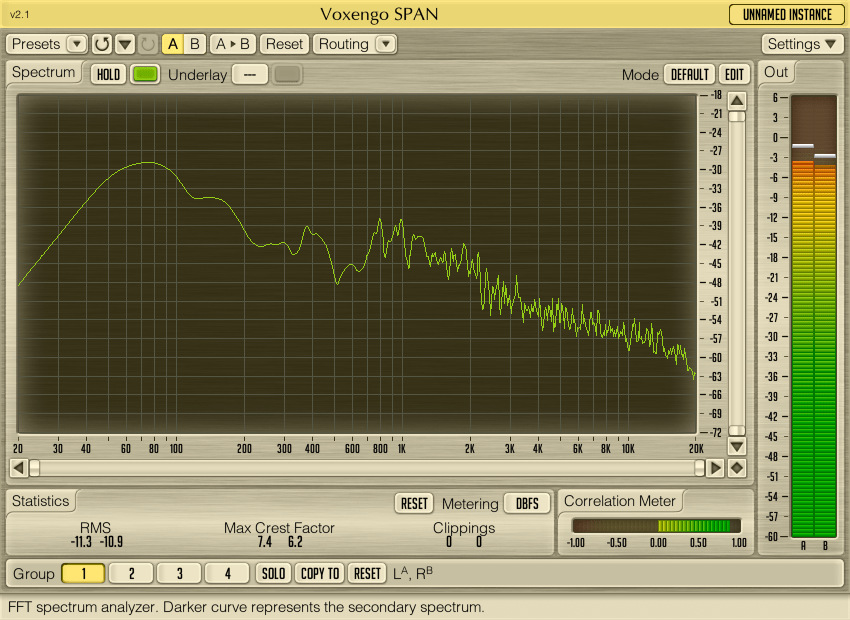| Author
|
eq and analyzer !!!
|
Obelizk
Amoeba

Started Topics :
115
Posts :
836
Posted : Mar 4, 2011 07:25
|
Voxengo span is cool, Voxengo GlissEQ is also very cool because it offers you EQ options on top of being able to see the frequency curve. GlissEQ costs some money though.
Orgytime has it right,
"you are right you sweep with a high peak through the spectrum, listen carefulle for "ringing" frequencies (just those, what are ringing more than others) then notch the ringing frequency with a high Q setting."
That's the gist of it. When you find those ringing frequencies, reduce them. But, at the same time you don't want to reduce all the dominant frequencies.
Example: if you're EQing a bass, some bass frequencies may sound big, but you don't want your bass to sound 'small,' so you really have to use your ears.
You'll always find those frequencies in the bass that sound like they are ringing but some of those frequencies are the ones that really give the bass that depth that you're looking for. Bypassing the EQs that you've found to be helpful, and vice versa while listening to tracks along with the full mix will help get you where you want to be. If your EQing isn't noticeable in the 'full mix' but is noticeable when the track is solo'd then cutting those ringing frequencies should increase the quality of your sound on a wider range of systems and should help your final mix sound better overall.
        www.musicproductionnatural.com || www.facebook.com/djamoeba | facebook page www.musicproductionnatural.com || www.facebook.com/djamoeba | facebook page |

|
|
mikechedelic
IsraTrance Junior Member

Started Topics :
29
Posts :
104
Posted : Mar 4, 2011 23:12
|
FUCKKK!! really great pieces of advice in here !!!!
cheers!!  ! !
ps:: tnks guys for those beautiful answers !!
        +vibes!!! +vibes!!!
msn: mva360@hotmail.com |

|
|
mikechedelic
IsraTrance Junior Member

Started Topics :
29
Posts :
104
Posted : Mar 4, 2011 23:13
|
Quote:
|
On 2011-03-02 10:10, orgytime wrote:
this has nothing to do with the analyzer, but your ears.
you are right you sweep with a high peak through the spectrum, listen carefulle for "ringing" frequencies (just those, what are ringing more than others) then notch the ringing frequency with a high Q setting.
if you got a better, more detailed analyzer (like free voxengo span), you also can see the critical feqeuencies... but this depends...

remember this kind of eqing needs much practice...
its hard to learn how much to take out, also always new ringing frequencies appear from cutting one out... also for much instruments, those ringing peaks are characteristic (sine waves for example), taking those out would kill the sound.
|
|
hey bro !! that page looks awesome !!!!
        +vibes!!! +vibes!!!
msn: mva360@hotmail.com |

|
|
orgytime
IsraTrance Full Member

Started Topics :
120
Posts :
1703
Posted : Mar 4, 2011 23:47
|
|
willsanquil
IsraTrance Full Member

Started Topics :
93
Posts :
2822
Posted : Mar 4, 2011 23:58
|
Quote:
|
On 2011-03-04 07:25, Obelizk wrote:
Voxengo span is cool, Voxengo GlissEQ is also very cool because it offers you EQ options on top of being able to see the frequency curve. GlissEQ costs some money though.
Orgytime has it right,
"you are right you sweep with a high peak through the spectrum, listen carefulle for "ringing" frequencies (just those, what are ringing more than others) then notch the ringing frequency with a high Q setting."
That's the gist of it. When you find those ringing frequencies, reduce them. But, at the same time you don't want to reduce all the dominant frequencies.
Example: if you're EQing a bass, some bass frequencies may sound big, but you don't want your bass to sound 'small,' so you really have to use your ears.
You'll always find those frequencies in the bass that sound like they are ringing but some of those frequencies are the ones that really give the bass that depth that you're looking for. Bypassing the EQs that you've found to be helpful, and vice versa while listening to tracks along with the full mix will help get you where you want to be. If your EQing isn't noticeable in the 'full mix' but is noticeable when the track is solo'd then cutting those ringing frequencies should increase the quality of your sound on a wider range of systems and should help your final mix sound better overall.
|
|
Doesn't cutting with a high Q setting induce ringing??
        If you want to make an apple pie from scratch...you must first invent the universe If you want to make an apple pie from scratch...you must first invent the universe
www.soundcloud.com/tasp
www.soundcloud.com/kinematic-records |

|
|
Obelizk
Amoeba

Started Topics :
115
Posts :
836
Posted : Mar 5, 2011 07:39
|
Quote:
|
On 2011-03-04 23:58, willsanquil wrote:
Quote:
|
On 2011-03-04 07:25, Obelizk wrote:
Voxengo span is cool, Voxengo GlissEQ is also very cool because it offers you EQ options on top of being able to see the frequency curve. GlissEQ costs some money though.
Orgytime has it right,
"you are right you sweep with a high peak through the spectrum, listen carefulle for "ringing" frequencies (just those, what are ringing more than others) then notch the ringing frequency with a high Q setting."
That's the gist of it. When you find those ringing frequencies, reduce them. But, at the same time you don't want to reduce all the dominant frequencies.
Example: if you're EQing a bass, some bass frequencies may sound big, but you don't want your bass to sound 'small,' so you really have to use your ears.
You'll always find those frequencies in the bass that sound like they are ringing but some of those frequencies are the ones that really give the bass that depth that you're looking for. Bypassing the EQs that you've found to be helpful, and vice versa while listening to tracks along with the full mix will help get you where you want to be. If your EQing isn't noticeable in the 'full mix' but is noticeable when the track is solo'd then cutting those ringing frequencies should increase the quality of your sound on a wider range of systems and should help your final mix sound better overall.
|
|
Doesn't cutting with a high Q setting induce ringing??
|
|
If you were to use a high Q setting to take out high frequencies, there's more of a chance that there would be some ringing, if in the lower frequencies, you can get away with using a narrower Q as it's less noticeable,
but what I was talking about was going through the frequency spectrum with a positive dB high Q, then sweeping the frequency spectrum with a negative dB high Q, just to see where everything is.
General rule is that you should use a wider Q in the higher frequencies and you can use a narrower Q in the bass frequencies, but it still all comes down to how it sounds.
        www.musicproductionnatural.com || www.facebook.com/djamoeba | facebook page www.musicproductionnatural.com || www.facebook.com/djamoeba | facebook page |

|
|
|